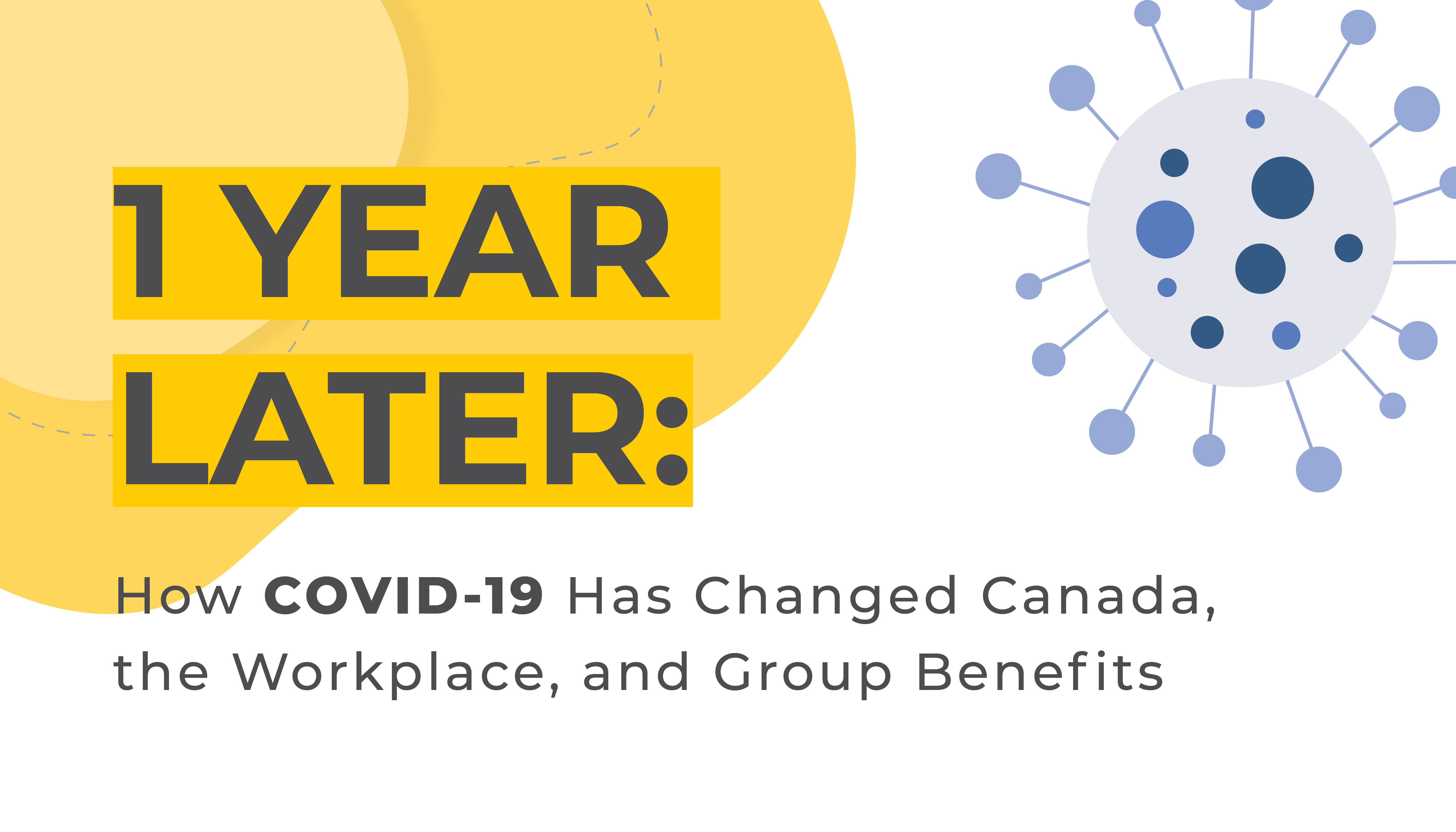1 Year Later: How COVID-19 Has Changed Canada, the Workplace, and Group Benefits
By: Benefits by Design | Tuesday March 23, 2021
Updated : Monday November 29, 2021
It’s been one year since Canada declared a state of emergency in response to the COVID-19 pandemic. Since then, both Canada and the world have changed, likely forever. Here are some of the most notable impacts and changes we’ve seen over the past year.
#1. Worsening Mental Health
Isolation and social distancing are impacting Canadians’ mental health, which is worsening the existing mental health crisis.
Increased Anxiety and Depression
Canadians are experiencing increased anxiety and depression, which is flowing through employers’ benefits plans as employees turn to anti-anxiety medication and antidepressants.
From January 2020 to June 2020, there was an 11% increase in the number of people who made claims for antidepressants, according to Express Scripts Canada’s research.

Impacts on Disability in Canada
According to the Mental Health Commission of Canada, mental health now accounts for 70% of total disability costs. The number of disability claims in Canada were rising before COVID-19, but as experts predict a continuation of the mental health crisis, costly disability claims are expected to continue to rise.
Addressing the Troubling Trend of Rising Disability Claims in Canada
#2. Employers Bolstering Their Benefits Plans
It’s not all doom and gloom! In the wake of the COVID-19 pandemic, proactive Canadian employers are stepping up to the challenge and beefing up their benefits plans to better protect employees.
Paramedicals and the Psychology Benefit
As employers, Advisors, and Insurers work together to adjust benefits plans in a time of crisis, one prevailing trend we’re seeing is within employers’ Extended Health Care (EHC) benefit.
Many employers, anticipating an increased need, are proactively setting a separate maximum for their psychology benefit, allowing employees greater access to counselling services and practitioners. Admittedly, this is a trend we’ve noticed within our own block of business, but we’re willing to bet it’s happening elsewhere, too.
Making Plan Amendments to Your Employee Benefits Plan During a Crisis
Employees Assistance Programs (EAP) on the Rise
Employers are adopting Employee Assistance Programs (EAP) to meet the increased mental health pressures on workers today. More Canadians are curious about EAPs and looking for more information (as our own site search can attest), and not only that but those with EAPs are actively using them more.
Our own EAP provider, HumanaCare, reported a 50% increase in call volume in January 2021 over historic levels, indicating that Canadians are seeking the help they need.
Download the EAP Report: Investing in Employee Wellbeing in 2020 and Beyond

#3. Adoption of Digital Health Resources
Traditionally, one of the biggest hurdles for these resources was adoption amongst general Canadians and practitioners.
Telehealth and Telemedicine Adoption Increased
However, digital health resources and telehealth options have exploded in usage during the COVID-19 pandemic as Canadians seek healthcare from the comfort, convenience, and safety of their own homes. Likewise, funding and government resources for these options have increased substantially.
Virtual Healthcare: Telehealth Services and Resources to Use During COVID-19
Acquisitions, Consolidations, and Partnerships Continue
The telehealth industry was arguably a hot market before COVID-19 and we’ve been predicting its growth for a while now.
The increased demand for these services has only accelerated this trend, and we saw a number of acquisitions and partnerships in 2020:
- Benefits by Design (BBD) Inc. and Green Shield Canada (GSC) partner with Phzio
- CloudMD acquires HumanaCare
- EmpireLife announces partnership with Teladoc
- Green Shield Canada (GSC) announces free access to Maple
We expect the adoption of telehealth services to continue to increase, even as acquisitions and consolidation continue.
#4. Remote Workforces: the Good and the Bad
Once a state of emergency was declared, many employers transitioned their workforces remote.
Good: Workplaces Adapted Quickly to Remote Work
Both employers and employees had to adapt quickly, adopting new technologies (see: Zoom Boom 169% revenue increase over the previous year) and updating internal processes previously done from the office.
As an example, Benefits by Design (BBD) Inc. transitioned all employees to work from home in March. That represented a significant effort from our Networking team to equip everyone with the equipment they needed to continue to work. Additionally, our Client Services team had to update many internal processes, such as issuing ID cards, in order to be done from home.

Bad: Remote Work and Mental Health
For many, remote work (coupled with isolation and social distancing measures) has been a tough transition and some Canadians are still having mixed feelings about it. Employers who have made this transition to remote work may need to couple it with employee-focused strategies and initiatives to match, such as paid sick days, personal time off, vacation incentives, and mental health programs and resources.
Remote work where possible remains necessary for the moment (and is likely here to stay), it may be contributing to increased incidences of presenteeism.
Good: Hybrid Workforces
The future of work is here, and experts agree that remote work is likely here to stay, at least in some capacity. What’s more, employers may need to face a reality where employees don’t want to return to the office — how will they handle it?
Most experts agree that some mix of work from home and office work “hybrid workforces” are where Canadian employers are likely to end up. This increased flexibility and choice in how Canadians work can only do good things for their engagement, job satisfaction, and employers’ talent acquisition efforts. Work from home options remain a highly sought after perk and will be a top consideration for employees in the future.
#5. Canadians Leaving the Big City
Canadians are leaving the big cities in record numbers as remote work becomes possible, allowing them to maintain their positions while finding more affordable living. After all, Toronto and Vancouver are among the top 10 most expensive cities to live in the world, and this departure of urban areas is a contributing factor to the current Canadian housing market.
This shift of Canadians fleeing large urban centres will further increase the trend towards a gig economy and hybrid workforces.
#6. Vaccine Rollouts and the Future of Benefits and Work
As vaccines begin to roll out to the Canadian population, people are beginning to see a light at the end of the tunnel, and dreaming of social gatherings and a phased return to office work.
But it’s important to remember that everything we’ve talked about here — the mental health impacts, trends in benefits, telehealth adoption, hybrid workforces — aren’t going anywhere. COVID-19 has permanently set in motion significant social, economic, and workplace trends that will shape the future of workplaces and benefits.
Employers, Insurers, Advisors, and Canadians on the whole, need to be ready.


